Complete Solutions to LEVEL -I of chapter ELECTROSTATICS of Class 12 book with complete answers and questions
| Class 12 | PHYSICS |
| Chapter | ELECTROSTATICS |
| MODERN PUBLICATION | LEVEL -I |
| Number Of Questions | 100 |
| Academic Year | 2023-24 |
A point charge Q is placed at the centre of a hemisphere. and plane surface of the hemisphere is :
View SolutionA point charge is projected along the axis of circular ring of charge Q and radius `10sqrt(2)` cm.' The distance of the point charge from center of ring, where acceleration of charged particle is maximum, will be :
View SolutionThe lines of force of the electric field of a positive charge (+q) and a negative charge (-q) are shown in figs. (a) and (b) below. Then :
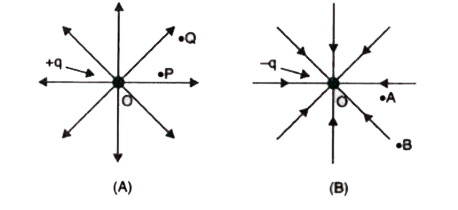 View Solution
View SolutionTwo equal negative charge -q are fixed at points (0, a) and (0, - a) on the y- axis. A positive charge Q is released from rest at a point (2a, 0) on the x-axis. The charge Q will
View SolutionA capacitor of capacitance C is charged to a potential V. The total flux of the electric field over a closed surface enclosing the capacitor is :
View SolutionFind the charges on capacitors in given system :
 View Solution
View SolutionFind the resultant capacitance of given system.
 View Solution
View SolutionWhat is the equivalent capacity of combination of capacitors ?
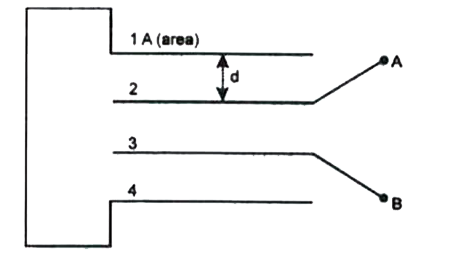 View Solution
View SolutionAn electric dipole is placed in a non- uniform electric field increasing along +ve direction of y-axis. In which direction does the dipole (i) move (ii) rotate?
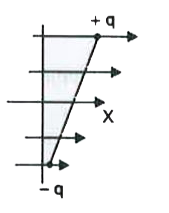 View Solution
View SolutionA capacitor is connected to a cell of emf E and of some internal resistance. The potential difference of :
View SolutionA conducting sphere of radius R carrying a charge Q is joined to an uncharged conducting sphere of radius 2R. The charge following between them will be :
View SolutionThe insulation property of air, breaks at ` E = 3 × 10^(6) ` volt per metre. The maximum charge that can be given to a sphere of diameter 5 meter is approximately (in coulomb) :
View SolutionA and B are two points on the axis and perpendicular bisector respectively of an electric dipole. A and B are far away from dipole and at equal distances from it. If fields at A and B `vec(E _(A)) and vec(E_(A))` are then :
View SolutionA spring block system undergoes veritcal oscillations above a large horizontal metal sheet with uniform positive charge. The time period of oscillation is T. If the block is given a charge Q, its time period of oscillation is :
View SolutionA half ring of radius R has charge `lambda` per unit length. The potential at its centre is :
View SolutionTwo charge + Q each are at a distance r from each other. A third charge q is placed in the line joining above two charges, so that all of them are in equilibrium. Find value of q.
View SolutionA certain charge Q is divided into two parts q and Q-q. What is relation between q and Q, if they have max. repulsive force between them ?
View SolutionA conducting sphere of radius R is charged to a pot. of V volt. The electric field at a distance `r (>R) `from center of sphere would be :
View SolutionThe work done in carrying a charge of ` 5 muC ` from point A to a point B in an electric field is 10cm J. The pot. Difference`V_(B) - V_(A)` is then :
View SolutionThe flux entering and leaving a closed surface are M.K.S. units respectively then charge inside the surface will be :
View SolutionA cylinder of radius R and length L is placed in a uniform electric field E, parallel to cylinder and axis. The total flux for surface of cylinder is given by.
View SolutionThe energy stored in the capacitor as shown in the figure (a) `4.5 xx10^(-4)` is J. If the battery is replaced by another capacitor of 900 pF as shown in figure (b), then the total energy system is :
 View Solution
View SolutionSix charge each equal to +Q are placed at corners of regular hexagon of side (l). The electric potential and electric field at point P where diagonals intersect are :
View SolutionA cylinderical capacitor has charge Q and length L . If both the charge and length of the capacitors are doubled, by keeping other parameters fixed, the energy stored in the capacitor
View SolutionA solid cylindrical uncharged conductor of radius R and length L is placed in a region of space where a uniform electric field ` vec(E )` exists. The electric filed inside the conductor due to the charge induced on its surface is
View SolutionA point charge q is placed at the geometric centre of one of the faces of a cubical surface due to the charge is :
View SolutionTwo identical particles each of mass m and charges -q and + q are revolving around their common centre of mass, in a circle of radius r, under the influence of electrostatic attraction. The kinetic energy of each particle is .
View SolutionTwo point charges q and -4q are placed at points A and B respectively, at a distance d apart as shown in the figure. The null point (the point where electric filed is zero) is :
 View Solution
View SolutionA parallel plate capacitor is charged from a cell and then isolated it. The sepration between the plates is now increased.
View SolutionForce acting upon a charged particle, kept between the charged pair of plates is F. If one of plates, is removed, force acting on the same particle will become :
View SolutionA test charge ` q_(0)` q is moved without Acceleration from point A to B through a path` Ato Cto B` . The potential difference between A and B is :
 View Solution
View SolutionFigure below shows two equipotential lines in xy-plane for an electric field. The scales are marked. The y-component `E_(y)` E and x-component `E_(x)` of the field in the space between these equipotential lines are, respectively :
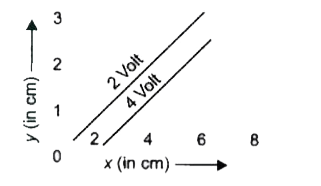 View Solution
View SolutionStatement-1 : The capacitance of a parallel plate capacitor increased, when a metallic slab is introduced between plates of a capacitor.
Statement-2 : The electric field inside metallic slab does not reduce to zero.View SolutionStatement-1 : If there exists coulomb attraction between two bodies, both of them may not be charged.
Statement-2 : In case of coulomb attraction the two charges are oppositeView SolutionStatement-1 : A dipole P applies a force `vec(F )` on dipole
Q and dipole Q applies a force ` - vec(F) `on dipole P.
Statement-2 : Action and reaction are equal and opposite.View SolutionStatement-1 : If the test charge at the observation point is doubled without changing the source charge, then electric field at that point is doubled.
Statement-2 : Electric force between the source charge and the test charge is directly proportional to the product of their charges.View SolutionTwo identical conducting spheres carrying different charges attract each other with a force F when placed in air medium at a distance 'd' apart. The spheres are brought into contact and then taken to their original positions. Now the two spheres repel each other with a force whose magnitude is equal to that of the initial attractive force. The ratio between initial charges on the spheres is :
View SolutionA soild spherical conductor of radius R has a spherical cavity of radius `a (a < R)` at its centre. A charge + Q is kept at the centre. The charge at the inner surface, outer and at a position` r (a < r < R) `are respectively
View SolutionForce of attraction between two point charges Q and - Q separated by d metre is` F_(e )`. When these charges are placed on two identical spheres of radius R = 0.3 d whose centres are d metre apart, the force of attraction between them is :
View SolutionConsider a neutral conducting sphere. A positive point charge is placed outside the sphere. The net charge on the sphere is then
View SolutionTwo identical charges repel each other with a force equal to 10 mg wt. When they are 0.6 m apart in air. `( g = 10 "ms"^(-2))`The value of each charge is :
View SolutionThe force between two charges 0.06 m apart is 5N. If each charge is moved towards the other by 0.01 m, then the force between them will become
View SolutionTwo small conducting spheres of equal radius have charges` +10 mu C and - 20 mu C ` respectively and placed at a distance R from each other experience force`F_(1)` . If they are brought in contact and separated to the same distance, they experience force`F_(2)` . The ratio of`F_(1)` to is `F_(2)` :
View SolutionTwo charges are at a distance 'd' aoart. If a copper plate (conducting medium) of thickness `d/2` is placed between them, the effective force will be
View SolutionTwo copper balls, each weighting 10 g are kept in air 10 cm apart. If one electron from every `10^(6)` atoms is transferred from one ball to the other, the coulomb force between them is : (Give atomic weight of copper is 63.5)
View SolutionTwo identical spheres carrying charges `-9 mu C and 5 mu C ` respectively are kept in contact and then separated from each other.Point out true statement from the following. In each sphere
View SolutionTwo positive ions, each carrying a charge q, are separated by a distance d. If F is the force of replulsion between the ions, the number of electrons missing from each ion will be : (e being the charge on an electron)
View SolutionTwo small spheres of masses `M_(1) and M_(2)` are suspended to weightless insulating threads of lenghts`L_(1) and L_(2)` . The sphere carry charges `Q_(1) and Q_(2)` respectively. The spheres are suspended such that they are in level with one another and the threads are inclined to the vertical at angles of` theta _(1) ans theta_(2)` as shown. When one of following conditions is essential, if `theta_(1) = theta_(2)`
 View Solution
View SolutionTwo charges `+ 6 mu C and + 15 mu C ` are placed along the x-axis at x = 0 and x = 2 m respectively. A negative charge is placed between them such that the resultant force on it is zero. The negative charge is placed at
View SolutionTwo charged spherical conductors of radii `R_(1) and R_(2)` are connected by a wire. Then the ratio of surface charge densities of the spheres `sigma_(1)//sigma_(2)` is :
View SolutionThree concentric spherical shells have radii a, b and c`(a < b < c )` and have surface charge densities and respectively. If`V_(A) , V_(B ) and V_(C )` and denote the potential of the three shells, then for ` c = a+ b ` we have
View SolutionThe electric potential at a point ( x, y, z) is given by `V= -x^(2)y-xz^(3)+4`
The electric field `vec(E )` at that point isView SolutionTwo spheres A and B of radius 4 cm and 6 cm are given charges of` 80 mu C and 40 mu C ` and respectively. If they are connected by a fine wire, the amount of charge flowing from one to the other is :
View SolutionThe electric field at a distance `(3R)/2` from the centre of a charged conducting spherical shellof radius R is E. The electric field at a distance shell `R/2 `from the centre of the sphere is :
View SolutionTwo insulated charged conducting spheres of radii 20 cm and 15 cm respectively and having an equal charge of 10c are connected by a copper wire and then they are separated. Then
View SolutionThree charges and are placed at the vertices of a right-angled isosceles triangle as shown. The net electrostatic energy of the configuration is zero if Q is equal to
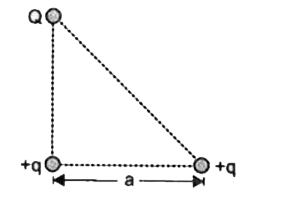 View Solution
View Solution4 point charges each is placed on the circumference of a circle of diameter 2d in such a way that they form a square. The potential at the centre is :
View SolutionA small conducting sphere of radius `r` is lying concentrically inside a bigger hollow conducting sphere with Q and ` q (Q > q)` and are insulated from each other. The potential difference between the spheres will be :
View SolutionA thin spherical conducting shell of radius R has a charge q. Another charge Q is placed at the centre of the shell. The electrostatic potential at a point p a distance R/2 from the centre of the shell is :
View SolutionA hollow conducting sphere is placed in an electric field produced by a point charge placed at P as shown in fig . Let `V_(A) , V_(B) and V_(C )` the potentials at points A, B and C respectively. Then
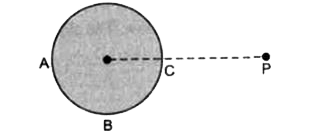 View Solution
View SolutionA point charge is kept at the centre of a metallic insulated spherical shell. Then
View SolutionAn electric dipole is placed along the at the origin O. A point P is at a distance of 20 cm from this origin such that OP makes an angle ` pi/3 ` with the x-axis. If the electric field at P makes an angle`theta ` with the x axis, the value of`theta ` would be :
View SolutionAn electric dipole conincides on Z-axis and its mid point is on origin of the co-ordinate system. The electric field at an axial z from origin `vec(E )_((z))` equatorial point at a distance y from origin is `vec( E )_((y))` . Here ` z = y gt gt a ` , so `|vec(E)_((z))/(vec(E )_((y)))| = .....`
View SolutionThree point charges are placed at points and respectively. The magnitude and direction of the electric dipole moment vector of this charge assembly are :
View SolutionThe figure shows the electric fields lines due to two positive charges. The magnitudes `E_(A), E_(B) and E_(C )` and of the electric fields at points A, B and C respectively are related as :
 View Solution
View SolutionThere is a uniform electric fields of intensity E which is as shown. How many labelled points have the same electric potential as the fully shaded point
 View Solution
View SolutionThe electrostatic potential of a uniformly charged thin spherical shell of charge Q and radius R at a distance r from the centre is
View SolutionElectric charge is uniformly distributed along a long straight wire of radius 1 mm. the charge per cm length of the wire is Q coulomb. Another cylindrical surface of radius 50 cm and length 1 m symmetrically encloses the wire as shown in the figure. The total electric flux passing through the cylindrical surface is :
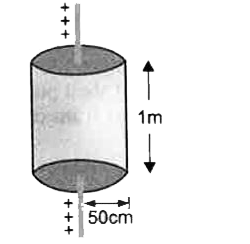 View Solution
View SolutionThe adjacent diagram shows a charge held on an insulating support S and enclosed by a hollow spherical conductor and P is a point such that and The electric field at point P will be :
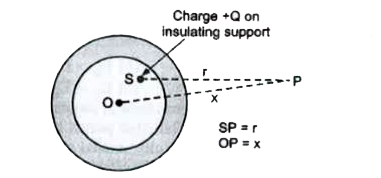 View Solution
View SolutionA condenser of capacity C is charged to a potential difference to an The plates of the condenser are then connected to an ideal inductor of inductance L. the current through the inductor when the potential difference across the condenser reduces to `V_(2)` is
View SolutionEquipotential surfaces are shown in figure. Then the electric field strength will be :
 View Solution
View SolutionIn a hollow spherical shell potential (V) changes with respect to distance (r) from centre
View SolutionThe variation of potential with distance R from a fixed point is as shown below. The electric field at `R = 5 m ` is :
 View Solution
View SolutionChange Q on a capcitor varies with voltage V as shown in the figure, where Q is taken along the X-axis and V along theY-axis. The area of triangle OAB represents.
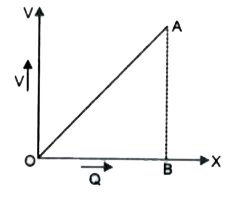 View Solution
View SolutionTwo concentric conducting thin spherical shells A, and B having radii `r_(A) and r_(B) ( r_(B) gt r_(A))` are charged to `Q_(A) and - Q_(B) (| Q_(B)| gt |Q_(A)|) ` . The electric field along a line, (passing through the centre) is :
View SolutionThree positive charges of equal value q are placed at the vertices of an equilateral triangle. The resulting lines of force should be sketched as in (see fig.) :
View SolutionA quantity X is given by `epsilon_(0) L (DeltaV)/(Deltat)` where is the permittivity of free space, L is a length, is a potential difference and`Delta t ` is a time interval. The dimensional formula for X is the same as that of :
View SolutionConsider the situation shown in figure.

The capacitor A has a charge q on it whereas B is uncharged. The charge appearing on the capacitor B a long time after the switch is closed is :View SolutionA uniform electric field pointing in positive x-direction exists in a region. Let A be the origin, B be the point on the x-axis ` x = +1` at and C be the point on the y-axis ` y = +1 ` cm . Then the potentials at the points A, B and C satisfy :
View SolutionA capacitor charges from a cell through a resistance. The time constant is T. In what time will the capacitor collect 10% of its final charge ?
View SolutionIn the above question, after how many time constant will the charge on the capacitor be 10% less than its final charge ?
View SolutionA capacitor of capacitance C has charge q. It is connected to an identical through a resistance. The heat produced in the resistance is :
View SolutionA parallel plate capacitor of capacitance` C = 5 mu C ` and plate separation 6 cm is connected to a 1 V batttery and charged. A dielectric constant K = 4 and thickness t = 4 cm is introduced between the plates of the capacitor. The additional charge that flows into the capacitor from the battery is :
View SolutionA capacitor of capacitance `C_(1) = 4 muC` is charged to `V_(1) = 80 V ` and another capacitor of capacitance`C_(2) = 6 muC` is charged to`V_(2) = 30 V ` . When they are connected together, the energy lost by the`4 mu F ` capacitor is :
View SolutionA parallel plate capacitor of capacity `C = 100 mu F ` is charged by a battery of E = 50V. The battery remains connected and if the plates of the capacitor are brought closer so that the distance between them becomes half the original distance, the additional energy given by the battery to the capacitor in joule is :
View SolutionThe effective capacitance of two capacitors of capacitances `C_(1) and C_(2) ` ( with `C_(2) gt C_(1)`) connected in parallel is 25/6 times the effective capacitance when they are connected in series. The ratio`(C_(2))/(C_(1))` is :
View SolutionA metallic shell has a point charge 'q' kept inside its cavity. Which one of the following diagram correctly represents the electric lines of forces ?
View SolutionThe potential difference between points P and Q in the circuit shown is Fig. is :
 View Solution
View SolutionA parallel plate capacitor is maintained at a certain potential difference. When a dielectric slab of thickness t =0.3 cm is introduced between the plates, the plate separation had to be increased by 0.2 cm in order to maintain the same potential difference between the plates. The dielectric constant of the slab is :
View SolutionThe electric field component in Fig. , are `E_(x) = alphax^(1//2), E_(y) = E_(z) = 0 ` in which`alpha = 800 ` N/C `m^(1//2)` Calculate the flux through the cube, and Assume that A= 0.1 M
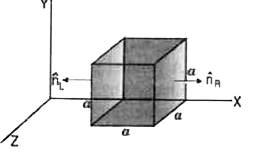 View Solution
View SolutionA capacitor of capacitance C is charged by connecting it to a battery. The battery is now removed and this capacitor is connected to a second uncharged capacitor of capacitance C' . If the charge distributes equally on the two capacitors, the ratio of the total energy stored in the capacitors after connection to the total energy stored in them before connection is :
View SolutionAn electric dipole is placed at an angle of 30° to a non-uniform electric field. The dipole will experience :
View SolutionTwo insulating plates are both uniformly charged in such a way that the potential difference between them is`V_(2) - V_(1) = 20 V ` (i.e. plate 2 is at a higher potential). The plates are separated by d = 0.1 m and can be treated as infinitely large. An electron is released from rest on the inner surface of plate 1. What is its speed when it hits plate 2 ?
`( e = 1.6 xx10^(-19) C , m_(e) = 9.11 xx10^(-31) kg)`
 View Solution
View SolutionThe potential at a point x (measured in ) due to some charges situated on the x-axis is given by
`V(x) = 20//(x^(2) - 4)`
The electric field E at `x = 4 mu m ` is given by :View SolutionA parallel plate condenser with a dielectric of dielectric constant K between the plates has a capacity C and is charged to a potential V volt. The dielectric slab is slowly removed from between the plates and then reniserted. The net work done by the system in this process is :
View SolutionAn electric charge`10^(-3) mu C ` is placed at the origin (0, 0) of X- Y co- ordinate system. Two points A and B are situated at `(sqrt(2), sqrt(2))`and respectively. The potential difference between the points A and B will be :
View SolutionCharges are placed on the vertices of a square as shown. Let `vec(E )`be the electric field and V the potential at the centre. If the charges on A and B are interchanged with those on D and C respectively, then
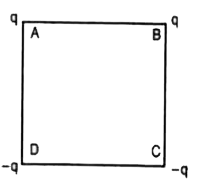 View Solution
View SolutionA battery is used to charge a parallel plate capacitor till the potential difference between the plates becomes equal to the electromotive force of the battery. The ratio of the energy stored in the capacitor and the work done by the battery will be :
View SolutionConsider a neutral conducting sphere. A positive point charge is placed outside the sphere. The net charge on the sphere is then,
View SolutionA spherical portion has been removed from a solid sphere having a charge distributed uniformly in its volume as shown in the figure. The electric field inside the emptied space is :
 View Solution
View Solution
LEVEL -I questions and complete solutions for chapter ELECTROSTATICS of MODERN PUBLICATION PHYSICS (KANNADA ENGLISH) of Class 12
